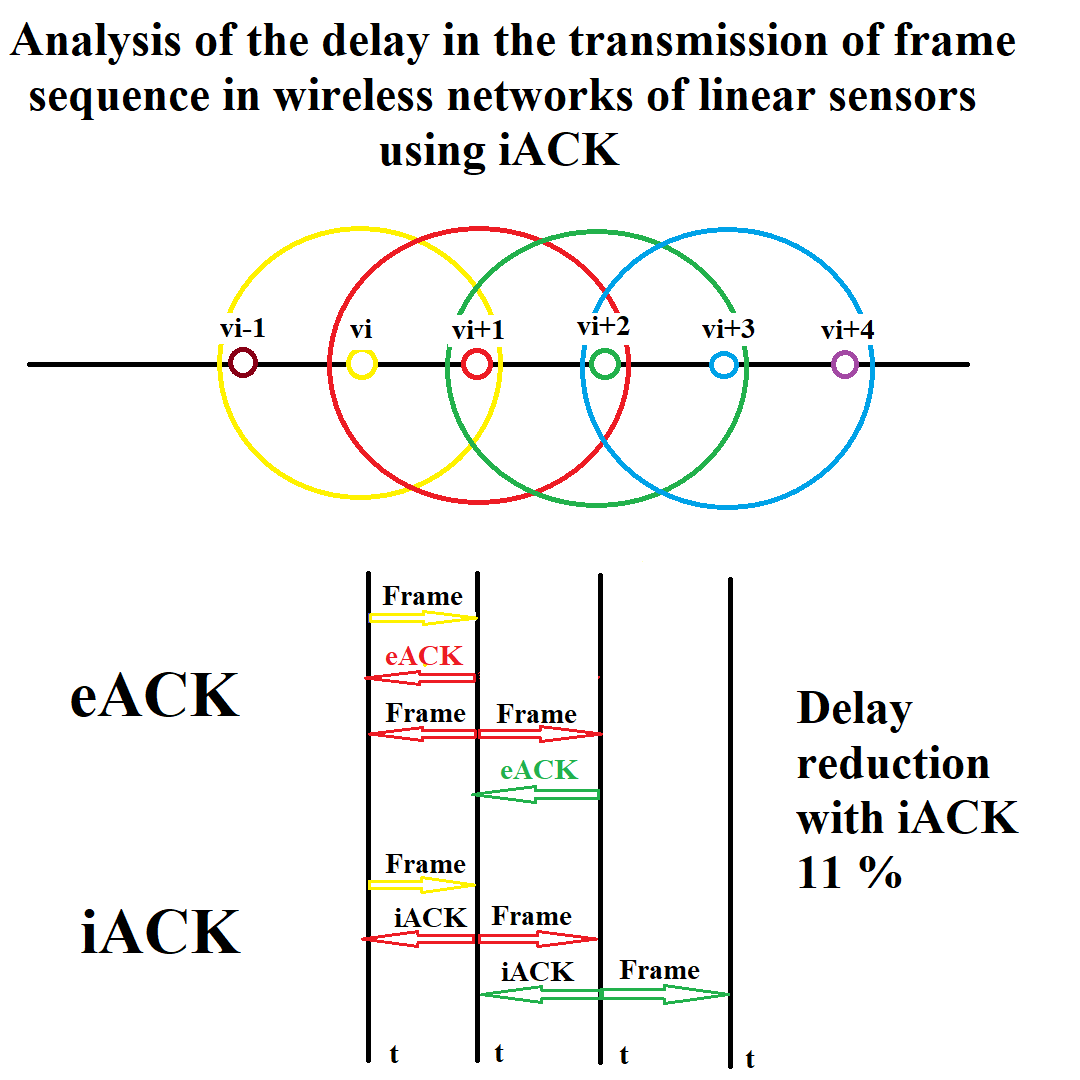Analysis of the Delay in the Transmission of Frame Sequence in Wireless Networks of Linear Sensors Using iACK
##plugins.themes.bootstrap3.article.main##
Abstract
Reliable transmission with low delay and low power are parameters that must be met in the design of multi-hop wireless linear sensor networks that operate with the IEEE 802.15.4 protocol. In order to minimize the processing delay in the node due to the confirmation of the reception of the frame, the implicit confirmation is used instead of the explicit confirmation maintaining the same reliability, which allows minimizing the end-to-end delays in multi-hop networks with linear topology with hundreds of nodes. The delays are mathematically analyzed when a node has to transmit or retransmit frame sequences in linear topologies using an implicit and explicit confirmation, and they are compared with the results obtained in a network prototype built for this purpose. The analysis reveals that the use of implicit confirmation in the transmission of frame sequences in linear topologies decreases the processing delay at the sensor node and the end-to-end delay.
##plugins.themes.revistapolitecnica.stadistisDownloadTitle##
Downloads
Article Details
References
Abbas, M. Z., Abu Bakar, K., Ayaz, M., & Mohamed, M. H. (2018). An overview of routing techniques for road and pipeline monitoring in linear sensor networks. Wireless Networks, 24(6). https://doi.org/10.1007/s11276-017-1457-6
Acosta, C. E., Gil-Castineira, F., & Gualotuna, C. E. (2020). Optimization of delays and power consumption in large-scale linear networks using iACK. 2020 IEEE ANDESCON, ANDESCON 2020. https://doi.org/10.1109/ANDESCON50619.2020.9272063
Agarwal, T. (2015). What is ZigBee Technology, Architecture and its Applications? In El-Pro-Cus.
Albaseer, A., & Baroudi, U. (2019). Node placement approaches for pipelines monitoring: Simulation and experimental analysis. International Journal of Sensor Networks, 29(3). https://doi.org/10.1504/IJSNET.2019.098281
Atmel®, A. (2014). ATmega 256RFR2 DataSheet. http://ww1.microchip.com/downloads/en/DeviceDoc/Atmel-8393-MCU_Wireless-ATmega256RFR2-ATmega128RFR2-ATmega64RFR2_Datasheet.pdf
Atmel® Corporation. (2014). ZigBit Extension User Guide. https://ww1.microchip.com/downloads/en/DeviceDoc/Atmel-42186-ZigBit Extension-User-Guide.pdf.
Bagci, F. (2016). Energy-efficient communication protocol for wireless sensor networks. Ad-Hoc and Sensor Wireless Networks, 30(3–4), 301-322.
Blagojevi´´c, M., Nabi, M., Geilen, M., Basten, T., Hendriks, T., & Steine, M. (2011). A probabilistic acknowledgment mechanism for wireless sensor networks. Proceedings of the 6th IEEE International Conference on Networking, Architecture, and Storage, China, 63-72. https://doi.org/10.1109/NAS.2011.38
Chen, Y., Hou, K. M., Zhou, H., Shi, H. L., Liu, X., Diao, X., Ding, H., Li, J. J., & De Vaulx, C. (2011). 6LoWPAN stacks: A survey. 7th International Conference on Wireless Communications, Networking and Mobile Computing, WiCOM 2011. https://doi.org/10.1109/wicom.2011.6040344
Dong, M., Ota, K., Liu, A., & Guo, M. (2016). Joint Optimization of Lifetime and Transport Delay under Reliability Constraint Wireless Sensor Networks. IEEE Transactions on Parallel and Distributed Systems, 27(1), 225-236. https://doi.org/10.1109/TPDS.2015.2388482
Egas Acosta, C., Gil-Castiñeira, F., & Costa-Montenegro, E. (2021). Red inalámbrica de sensores con topología lineal sin capa de red. Revista de Investigación En Tecnologías de La Información, 9(17), 56-65. https://doi.org/10.36825/riti.09.17.006
IEEE Standard. (2006). IEEE standard for local and metropolitan area networks. Part 15.4: Wireless Medium Access Control (MAC) and Physical Layer (PHY) Specifications. IEEE Std 802.15.4-2006
Imran, C. M., Aldukhail, M., Almezeini, N., & Alnuem, M. (2016). Potential Applications of Linear Wireless Sensor Networks: A Survey. International Journal of Computer Networks and Communications Security, 4(6), 183-200.
Kumar S., A. A., Ovsthus, K., & Kristensen., L. M. (2014). An industrial perspective on wireless sensor networks-a survey of requirements, protocols, and challenges. IEEE Communications Surveys and Tutorials, 16(3), 1391–1412. https://doi.org/10.1109/SURV.2014.012114.00058
Latré, B., De Mil, P., Moerman, I., Van Dierdonck, N., Dhoedt, B., & Demeester, P. (2005). Maximum throughput and minimum delay in IEEE 802.15.4. In: Jia, X., Wu, J., He, Y. (eds) Mobile Ad-hoc and Sensor Networks. MSN 2005. Lecture Notes in Computer Science. https://doi.org/10.1007/11599463_84
Lee, M. Y., Azman, A. S., Subramaniam, S. K., & Feroz, F. S. (2020). Performance Analysis of Linear Topology Wireless Sensor Network in Oil and Gas Industry. IOP Conference Series: Materials Science and Engineering, 765(1). https://doi.org/10.1088/1757-899X/765/1/012070
Li, S., Dou, Z., Wang, F., & Xu, Q. (2019). Energy efficiency of five broadcast-based ARQ protocols in multi-hop wireless sensor networks. IET Communications, 13(15), 2243-2253. https://doi.org/10.1049/iet-com.2018.6098
Luo, F., Feng, T., & Zheng, L. (2021). Formal Security Evaluation and Improvement of Wireless HART Protocol in Industrial Wireless Network. Security and Communication Networks, 2021, Article ID 8090547, 1-15. https://doi.org/10.1155/2021/8090547
Microchip. (2016). No Title. https://onlinedocs.microchip.com/pr/GUID-16A6E967-ABB5-42D8-BBED-6F0DBB16B126-en-US-1/index.html
Microchip. (2020). Microchip Studio for AVR® and SAM Devices.
Rosberg, Z., Liu, R. P., Y.dong, A., D.tuan, L., & Jha, S. (2008). ARQ with implicit and explicit ACKs in wireless sensor networks. GLOBECOM - IEEE Global Telecommunications Conference, USA, 1-6. https://doi.org/10.1109/GLOCOM.2008.ECP.18
Sen, S. K. (2021). ISA100.11a. In Fieldbus and Networking in Process Automation. https://doi.org/10.1201/9781003149941-26
Shanti, C., & Sahoo, A. (2014). Energy Efficient and Reliable Transmission of Data in Wireless Sensor Networks. In: Satapathy, S., Avadhani, P., Udgata, S., Lakshminarayana, S. (Eds.), ICT and Critical Infrastructure: Proceedings of the 48th Annual Convention of Computer Society of India- Vol I. Advances in Intelligent Systems and Computing, vol 248. Springer, Cham. https://doi.org/10.1007/978-3-319-03107-1_37S
Sokullu, R. I., & Demir, E. (2018). Linear wireless sensor networks and protocols in the next-generation networks. In Enhanced Living Environments. https://doi.org/10.1049/PBHE010E_ch10
Tharatipayakul, K., Gordon, S., & Kaemarungsi, K. (2014). IACK: Implicit acknowledgements to improve multicast reliability in wireless sensor networks. 2014 11th International Conference on Electrical Engineering/Electronics, Computer, Telecommunications and Information Technology, ECTI-CON 2014. https://doi.org/10.1109/ECTICon.2014.6839749
Varshney, S., Kumar, C., & Swaroop, A. (2021). Lightning-Based Lion Optimization Algorithm for Monitoring the Pipelines Using Linear Wireless Sensor Network. Wireless Personal Communications, 117(3), pages 2475–2494. https://doi.org/10.1007/s11277-020-07987-8
Varshney, S., Rajput, P. K., Singh, A., & Varshney, G. (2019). Routing Techniques used for Monitoring the Linear Structures using Linear Wireless Sensor Networks: An Overview. Proceedings - 2019 International Conference on Computing, Communication, and Intelligent Systems, ICCCIS 2019, 2019-January, Greater Noida, India, 126-130. https://doi.org/10.1109/ICCCIS48478.2019.8974522




